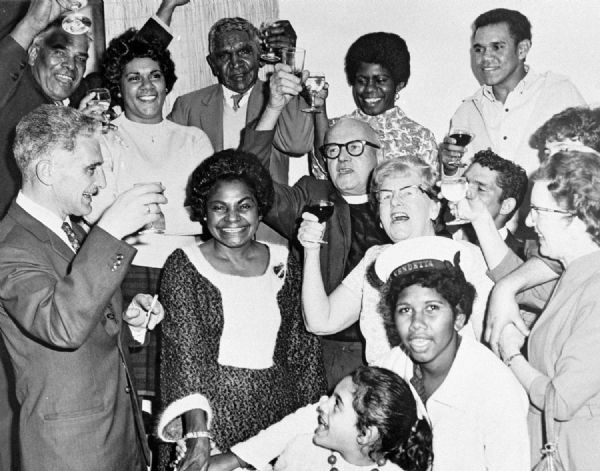
Members of the NSW Vote YES committee toast their campaign director, Faith Bandler (front, second from left), after the success of the 1967 Referendum. Hans Bandler to her right, Lilon Bandler in front. Bert Groves is directly behind Faith Bandler. Harriet Ellis is behind Hans Bandler. Edna Blackshaw is on Faith Bandler's left and Rev. Alf Clint is behind her on the right.
Source: Photographer unknown.
The two worlds of post-war Australia
The majority
In the period following the Second World War, the vast majority of Australians lived in a world of houses serviced with water and power, and where laws ensured social order. People on the whole had jobs to do and enough to eat and, if they didn't, government benefits and services helped them through hard times. Mostly they lived in or near cities. They were proud to be subjects of the Queen and believed that they lived in a fair and just democracy, unhindered by problems such as class distinctions in Britain, or racial tensions in the United States or South Africa.
The Indigenous minority
The other world was inhabited by people whose ancestors had lived in Australia for more than 40,000 years. By the 1950s, having lost land and livelihood, many were paupers, living in 'humpies' on the edge of town rubbish dumps and earning occasional money as fruit pickers. They were not eligible for the dole or other state benefits which whites received. State laws told Indigenous people where they were allowed to live, where they could and couldn't move and who they could marry. They were often not the legal guardians of their own children. Local policemen controlled their earnings, doling out small amounts in pocket money according to their individual judgement or whim. In Queensland the law even allowed mission managers to open and censor mission-dwellers' letters.
Bridging the gulf
There was little contact between the inhabitants of these two worlds. The majority either didn't know or didn't care about the sufferings of the minority. However, events in the late 1950s brought the sufferings of the few into the living rooms of the many. Some were both aware of Aboriginal disadvantage and doing what they could to address it. They recognised the potential to form a grass-roots reform movement to bring the rights and protection of Australian citizenship to the dispossessed Aboriginal population.
Civil rights activism
From the late 1950s, Aboriginal and non-Aboriginal activists came together to:
- campaign for equal rights for Indigenous Australians, and
- to bring about the repeal of laws which deprived Indigenous Australians of civil liberties.
'Fights for Civil Rights' is an account of seven key civil rights campaigns and the activists and organisations that participated in them. It begins with the Warburton Ranges campaign in the 1950s.